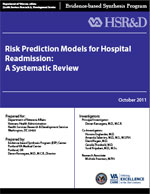
|
Principal Investigator: Devan Kansagara, M.D., M.C.R. Co-Investigators: Amanda Salanitro, M.D., M.S., M.S.P.H. David Kagen, M.D. Cecelia Theobald, M.D. Sunil Kripalani, M.D., M.Sc. Evidence-based Synthesis Program (ESP) Center
Portland VA Medical Center Washington (DC): Department of Veterans Affairs; October 2011 |
Download PDF: Complete Report, Executive Summary, Report, Appendices
An increasing body of literature attempts to describe and validate hospital readmission risk prediction tools. Interest in such models has grown for two reasons. First, transitional care interventions may reduce readmissions among chronically ill adults. Readmission risk assessment could be used to help target the delivery of these resource-intensive interventions to the patients at greatest risk. Ideally, models designed for this purpose would provide clinically relevant stratification of readmission risk and give information early enough during the hospitalization to trigger a transitional care intervention, many of which involve discharge planning and begin well before hospital discharge. Second, there is interest in using readmission rates as a quality metric. Recently, the Centers for Medicare & Medicaid Services (CMS) began using readmission rate as a publicly reported metric, with plans to lower reimbursement to hospitals with excess risk-standardized readmission rates. Valid risk adjustment methods are required for calculation of risk-standardized readmission rates which could, in turn, be used for hospital comparison, public reporting, and reimbursement determinations. Models designed for these purposes should have good predictive ability; be deployable in large populations; use reliable data that can be easily obtained; and use variables that are clinically related to, and validated in, the populations in which use is intended.
This systematic review was performed to synthesize the available literature on validated readmission risk prediction models, describe their performance, and assess their suitability for clinical or administrative use.